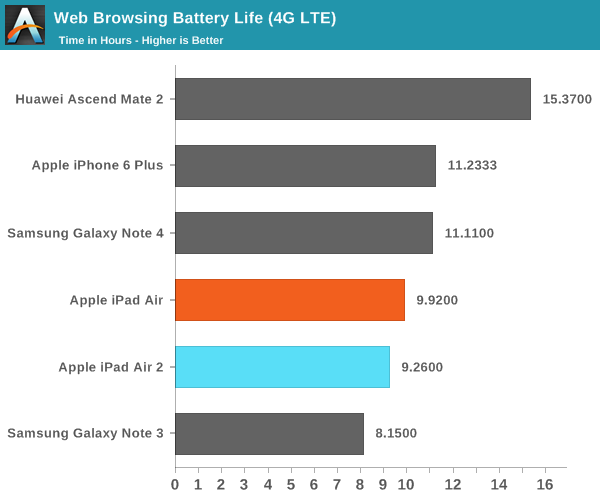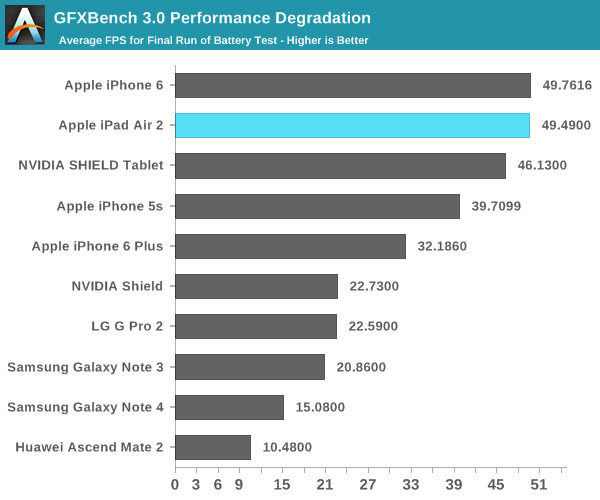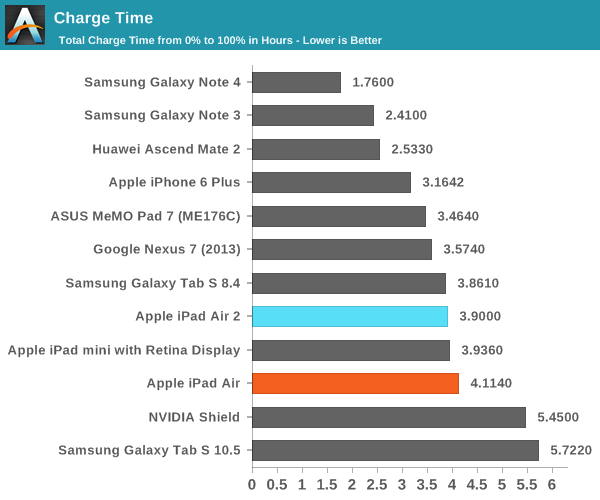The Apple iPad Air 2 Review
by Joshua Ho on November 7, 2014 9:30 AM EST- Posted in
- Tablets
- Apple
- Mobile
- iOS
- ipad Air 2
Battery Life
With the move from featurephones to smartphones, battery life has been and continues to be a critical issue. While it wasn’t unusual to see a week or more of battery life on a featurephone, some of the earliest smartphones couldn’t even last a day. While tablets seem to have a much easier time achieving high levels of battery life by virtue of massively increased volume, they still face similar issues as they are often used for gaming or other more intensive workloads that a smartphone is unlikely to see nearly as often. In order to test this, we run our tablets through a standard suite of tests of various use cases. In all cases where the display is on, all displays are calibrated to a brightness of 200 nits to draw useful relative comparisons.

In our first test, we see that the iPad Air 2 is about roughly equivalent to the original iPad Air for WiFi web browsing. This is actually a bit surprising as the battery in the iPad Air 2 is approximately 84% of the iPad Air. This would mean that we would expect the iPad Air 2 to get around 8.4 hours of battery life in this test, which represents a 16% gain to efficiency. It’s likely that these improvements to battery life come from the new process node on the A8X, along with the newer WiFi module.

Along the same lines, the LTE web browsing test tracks quite closely but it seems that there’s a minor decrease in efficiency gains when compared to WiFi. This difference is likely to be explained by the much higher bandwidth available in WiFi when compared to LTE.
While the web browsing tests are effective at ensuring faster SoCs aren’t punished, this inherently tilts battery life towards a more display-bound mode rather than compute-bound. Unfortunately short of a jailbreak it doesn’t seem possible to get an effective Basemark OS II battery test, so we’re mostly limited to a test of GFXBench’s unlimited rundown.


As one can see, the iPad Air 2 is one of the best performers on this test, considering its frame rate and runtime. While NVIDIA's GK20A GPU in Tegra K1 can get close to the GX6650 for short periods of time, over a long workload it's pretty clear that the GX6650 on 20nm has better sustained performance and significantly superior efficiency as it doesn't throttle until the 200th iteration of the test. It's important to note that the iPad Air 2 is running at a higher native resolution here, so relative to SHIELD Tablet a scaling factor needs to be estimated in order to get an idea for performance at the same resolution. During this test I saw that the skin temperatures never exceeded 45C, so this isn't the result of Apple choosing to run the device hotter than most.
Charge Time
While tablets deliver some great battery life in general, charge time tends to be much slower than that of smartphones as the battery is much larger and charging the device isn't as time critical due to the longer battery life . While we can't quite cover the full range of battery life uses cases, it's important to remember that in cases where the platform is otherwise identical beyond display that battery life scales linearly with overall capacity. In order to test charge time, we measure the time it takes for the battery to reach 100% from a fully-depleted state.

As one can see, the smaller battery seems to have a noticeable impact on charge time, although the difference isn't really all that notable as the difference is only around ten minutes at the end of the day.











226 Comments
View All Comments
deontologist - Friday, November 7, 2014 - link
About time this review went up.odedia - Friday, November 7, 2014 - link
Will you review the iMac 5k? I'm waiting for the review before purchasing. Mainly ssd&gpu performance.Ryan Smith - Friday, November 7, 2014 - link
The Retina iMac review will be next week. However it's the base model, so you're looking at a 1TB Fusion drive setup rather than a pure SSD, and the GPU is basically just Radeon HD 7870.odedia - Saturday, November 8, 2014 - link
That's too bad... I would expect the majority of those buying this aching to at least bump up the Cpu and more importantly -the GPU.ws3 - Saturday, November 8, 2014 - link
Bumping up the GPU is only "more important" for people who play high-end games. For most iMac users it is unnecessary. For example, if I were to buy the 5k iMac I would use it mainly for programming, and not for programming high-end games, so the GPU upgrade wouldn't be necessary for me.deontologist - Friday, November 7, 2014 - link
“Enhanced Cyclone” is still at the top of its class for both IPC and overall single-threaded performance" ... the Apple bias is strong. I like how you guys cite Geekbench scores while failing to note that the Nexus 9 with its Tegra K1 running **32 bit** Geekbench still outscores the A8X. Granted, the K1 is running at 2.3 GHz, so its IPC might be a bit lower than the A8X's 1.5 GHz, but overall single-threaded goes to the K1 no sweat. When 64-bit GB is ready I expect the K1 to blow the A8X out of the water.tipoo - Friday, November 7, 2014 - link
They waited on newer firmware before making conclusions on the Nexus 9. If anything you should be thankful for that, so relax.steven75 - Friday, November 7, 2014 - link
Speaking of bias... The Geekbench score I saw were not at all clearly for the K1.blackcrayon - Friday, November 7, 2014 - link
The single core performance of both seems to be similar, so perhaps they're both at the top of their class. The Apple whining is strong (with you).techconc - Friday, November 7, 2014 - link
I'm not sure exactly what your issue is. The statement about the A8X having the highest IPC is a fact. This is not in dispute. You even acknowledge the clock speed difference in your post. How exactly do you interpret this as a bias?